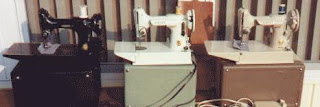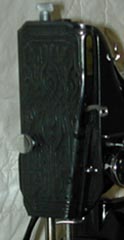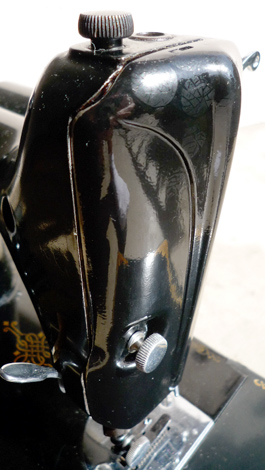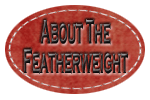Singer Featherweight 221 222 Tension adjustment by Alex Sussex
Again, thank you Alex Sussex for all your contributions about the Singer Featherweight!
Gail Pickens-Barger 3/2017
From: AlexSussex@aol.com
LOWER TENSION ADJUSTMENT PART ONE
ALEX ENGLAND
I am sending this message in two parts so look for the second part and join
them up for a complete guide.
Now that I have caught up a little I can get back to putting a few things on
the digests. Today I am going to talk about one of the most misunderstood
parts of the sewing machine.
LOWER THREAD TENSION ADJUSTMENT.
Only the brave or the foolish should read on. In many instruction manuals it
will say something like, the lower tension is set at the factory and should
not be adjusted. That is all and well, but twenty years have passed the
factory closed and your tensions are all over the place, you have got
sewing to do and you want it right.
At the tender age of seventeen one of my masters took me through the
basics of tension adjustments, then spent the next twenty years trying to
hammer it into me how important it is to every sewing machine ever made.
No matter if you have the latest all singing all dancing computer that talks
to you and does the washing up for you or a hundred year old antique
that simply looks lovingly at you but wont perform.
If you are having trouble with your sewing machine stitch quality and you
have done all the usual things, like played around with the top tension for a
week, thrown the machine out of the bedroom window and then tried to
see if it will still work before telling your husband that you were burgled
and the thieves dropped your machine whilst escaping. There is the
possibility that the lower tension of the machine is out of balance.
Now before we go any further, do not, I repeat, do not adjust your machine if you are happy with your stitch. A simple test if your tensions are well balanced is to sew a piece of cotton fabric about six inches in length, then get the ends of the thread that are left and give them a sharp tug. Now if the tensions are good the thread should snap without pulling out of the work, in other words, you have a proper LOCK STITCH.
If you find that the thread is pulling out of one side or the other then you are
out of balance and your threads are not lockedinto the fabric, leading to a
weak seam. Tension balancing is a little understood procedure and many so
called repair people will mess around with the wrong part of your machine
and make little or no improvement. How many of you have taken your sickly
machines into a shop for a service and received them back smothered in oil
and not much better with a nice bill for nothing.
Well, here goes I will try and explain the enigma that has eluded people for
so long. Even the great inventor Isaac Singer had terrible trouble getting
the tensions right on his first patent model, so you are not alone.
The classic symptoms of lower tension collapse are quite obvious. Look
at your stitch and see if the lower thread has pulled through to the top of
the fabric, the underneath will look fine perhaps a little loose, however the
top thread will be able to be pulled out of the fabric.
This is because the lower thread is laying on the fabric, not pulling
the top thread into the fabric. You will notice with this symptom that
you have little or no effect by altering the top tension dial and often think
that it is a top tension dial fault.
O. K so here goes, hold on tight it is going to get nasty, have your
painkillers ready. Step one, setting the top tension. Assuming that your top
tension is working can be a fatal flaw but is easily checked. Most sewing
machines even quite early ones have automatic top tension release
mechanisms.
This means that once the sewing foot is raised the top thread tension is
automatically released so that you can pull your work out of the machine
without the thread breaking.
To test this simply raise your sewing foot and see if the thread pulls out easier than if it were lowered ready for sewing.
To test if the thread is being held by the tension discs properly when ready
for sewing, you need to pull the thread from where it comes out of the eye of the needle-with the foot lowered.
The thread ON ALL MACHINES should be tight enough to bend the needle
when pulled. If it does not then you need to investigate why it is not
tight.
The most common reason is a restriction between the tension discs
themselves, caused by fluff, corrosion or trapped threads. a loose top
thread leads to a bunching of thread UNDERNEATH the work (or looping
on minor tension failure).
Once you have done this put your numbered tension dial halfway, for instance if you have a dial that goes from one to four put it on two,
one to nine put in between the four and five, get the idea. on older machines with no tension dial numbers turn the dial clockwise until the thread bends the needle when pulled through as I have mentioned earlier.
Then leave the top thread tension alone. Well, by now only
the mad will still be with me the brave and the foolish have gone out for
pizza, and we have not even got to the lower thread tension that we are going to discuss. That will be part two further down.
ALEX SUSSEX
SEWING MACHINES
EASTBOURNE ENGLAND
LOWER THREAD ADJUSTMENT PART TWO, Singer Featherweight
Sewing Machine ALEX, ENGLAND
This is the second and final part of lower thread adjustment.
Now the lower tensions fall into basically two types for lock stitch
machines. Ones with bobbin cases and ones without. We have to deal
with eachseparately but both have common symptoms and cures. So I
will take the machines with bobbin cases first. It is important to
say at this stage that sewing threads alter a great deal in thickness
and stickyness (that is definitely not a word but you know what I mean).
I once had a call out to Brighton District General Hospital because
twelve machines had all broken down on the same day, only to
discover it was a faulty batch of new thread. If you look closely at,
for instance a new polyester and put it against an old reel of cotton,
you know the one that you just could not throw away from your grannies
old stuff because you might just need a sunset orange thread one day.
You will notice that the new polyester can be up to half the
thickness of the old cotton. In simple terms, this means that by switching
from polyester to the old cotton you have instantly changed the thread
tension by a huge amount and this can lead instantly to a poor stitch. How
many times have you put your trusty old sewing machine away working
perfectly, and a few days later it is messing about. What you have not
realised is that it is possible that the change in thread has caused this
problem. Some sticky old cottons are only fit for hand sewing or tacking or
winding onto your husbands fishing reel so that he can tell you of the
monster that got away.
Always keep a reel of new White thread handy and if
your machine plays up switch to it and see if the stitch is better, nine
times out of ten the thread is the culprit and you just have to be brave and
bin it, or chuck it at a neighbors cat that has just dug up your flower bed
(perfect weight and size for that, so I am told). Now where was I, Oh yes
back to the all important bobbin case thread adjustment. Wind a full bobbin
of new white thread the same type that you normally sew with, it is not
important if it is silk, cotton, polyester or a mix, just your usual thread.
Place the bobbin into the bobbin case and suspend the bobbin by the thread, like a spider hanging from a thread.
Now we are getting to the nitty-gritty of tension adjustment the real bread and beans of the matter. If when you hold the thread the case simply drops to the floor you need to adjust the bobbin case screw clockwise until it just holds its own weight, So that when you shake it a little it drops a little.
It is not so important which way you put the bobbin into the case, some find a machine sews better with the bobbin going one way some the other, only trial and error points this out for your machine (loads of people are going to disagree with this, never mind). Now whilst the spider, opps, bobbin and case are suspended by the thread simply jerk your hand a little and see what the case does.
This is the MAGIC point known in the trade as the balance point for your type of thread. If the case does not move you need to adjust the bobbin case screw anticlockwise until it drops a little accordingly. Once you have mastered this adjustment you will be in great demand at all sewing classes as you transform misbehaving sewing machines in an instant.
Hold on I am not finished, no happy dancing just yet, no running out and buying twenty lottery tickets because you feel lucky (remember me if you win). Although this is the balance point some machines need to be adjusted slightly tighter or looser for the perfect stitch. When adjusting from this point make only very small movements of the screw, about one-sixteenth of a turn at a time.
After each adjustment run a trial stitch and examine. Once you are nearly right you can go back to the top tension unit again and make final adjustments say from a four to a five to get it just perfect.
machine, you know the ones where you just drop in the bobbin and hook it
around the spring plate is much the same. You need to do this more by feel, you need to FEEL the thread resistance by pulling the thread.
Adjusting the newer type plastic cases that are set permanently into the
One of the ways to do this is to place a fine hand sewing needle into a cork (pinch one of your husbands or better still open up a new bottle of wine with dinner) so that about two inches of the needle is protruding from the cork. Then tie the thread from the machine case through the eye of the needle and whilst holding the bottom of the cork pull the thread.
Now it should have a slight resistance and slightly, only slightly bend the needle. Once again if it does not you need to tighten the case adjustment screw clockwise. If it bends too much you need to loosen it a touch, remember tiny adjustments only. Well, hey presto that is it, if you can master lower thread adjustment you will have a control of your machine rather than it controlling you. One final point (by now the painkillers for that pounding headache have started to work) if you mix your threads it is a lottery whether the tensions will work effectively.
The worst culprits are the old wooden reels of cotton that can
become hard, springy, weak and sticky they can really mess up your sewing
machine, big time. Try and stick to the same threads, if in doubt about a
thread, bin it, really all the grey hairs and profanities it can cause is
just not worth it.
It has taken me three hours to type out and explain something that really only
takes a few seconds to perform. Now you know why instruction books
hardly ever mention lower thread adjustments.
I hope this has helped any of you that have a tension problem. It has
From ALEX SUSSEX SEWING MACHINES
EASTBOURNE, GREAT BRITAIN





















